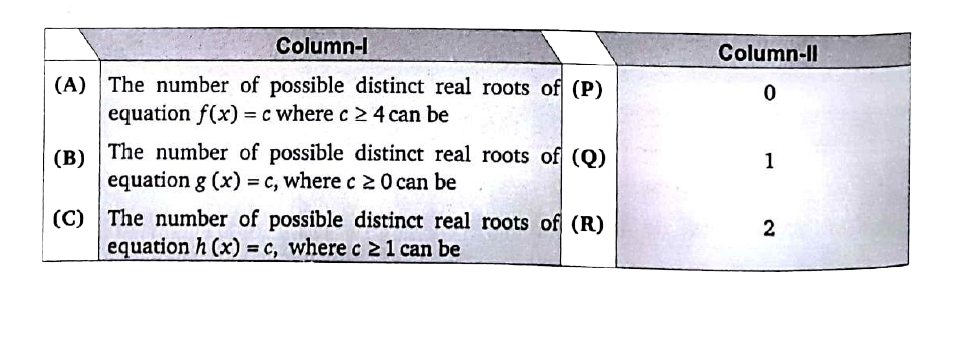where then is
a) increasing in
b) increasing in
c) decreasing in
d) decreasing in
The correct Answer is:A, B, C, D
To solve the problem, we need to analyze the function h(x)=3f(x23)+f(3−x2) given that f′′(x)>0 for x∈(−3,4). This condition implies that f′(x) is a strictly increasing function.
Step 1: Find the derivative of h(x)
To determine the monotonicity of h(x), we first need to compute its derivative h′(x):
h′(x)=ddx(3f(x23))+ddx(f(3−x2))
Using the chain rule, we have:
h′(x)=3⋅f′(x23)⋅ddx(x23)+f′(3−x2)⋅ddx(3−x2)
Calculating the derivatives:
ddx(x23)=2x3
ddx(3−x2)=−2x
Substituting these back into the expression for h′(x):
h′(x)=3⋅f′(x23)⋅2x3−2x⋅f′(3−x2)
This simplifies to:
h′(x)=2x(f′(x23)−f′(3−x2))
Step 2: Analyze the sign of h′(x)
Since f′′(x)>0, f′(x) is strictly increasing. Therefore, we can analyze the expression f′(x23)−f′(3−x2):
- If x>0, then x23<3−x2 for x2<9 (which is true for x<3). Thus, f′(x23)<f′(3−x2) leading to h′(x)<0.
- If x<0, then x23>3−x2 for x2<9. Thus, f′(x23)>f′(3−x2) leading to h′(x)>0.
Step 3: Determine intervals of increase and decrease
From the analysis:
- h(x) is increasing for x<0.
- h(x) is decreasing for x>0.
Step 4: Identify critical points and behavior at endpoints
The critical point occurs at x=0:
- As x approaches 0 from the left, h(x) increases.
- As x approaches 0 from the right, h(x) decreases.
Thus, h(x) has a maximum at x=0.
Conclusion
The function h(x) is:
- Increasing on the interval (−3,0).
- Decreasing on the interval (0,4).
Final Answer
Thus, h(x) has a maximum at x=0 and is increasing on (−3,0) and decreasing on (0,4).
---
ddx(3−x2)=−2x
- If x<0, then x23>3−x2 for x2<9. Thus, f′(x23)>f′(3−x2) leading to h′(x)>0.
- h(x) is decreasing for x>0.
- As x approaches 0 from the right, h(x) decreases.
- Decreasing on the interval (0,4).
Topper's Solved these Questions
- MONOTONICITY MAXIMA AND MINIMABOOK - ARIHANT MATHS ENGLISHCHAPTER - MONOTONICITY MAXIMA AND MINIMAEXERCISE - Exercise (Statement I And Ii Type Questions)
8 Videos
- MONOTONICITY MAXIMA AND MINIMABOOK - ARIHANT MATHS ENGLISHCHAPTER - MONOTONICITY MAXIMA AND MINIMAEXERCISE - Exercise (Passage Based Questions)
33 Videos
- MONOTONICITY MAXIMA AND MINIMABOOK - ARIHANT MATHS ENGLISHCHAPTER - MONOTONICITY MAXIMA AND MINIMAEXERCISE - Exercise (Single Option Correct Type Questions)
27 Videos
- MATRICES BOOK - ARIHANT MATHS ENGLISHCHAPTER - MATRICES EXERCISE - Exercise (Questions Asked In Previous 13 Years Exam)
49 Videos
- PAIR OF STRAIGHT LINES BOOK - ARIHANT MATHS ENGLISHCHAPTER - PAIR OF STRAIGHT LINES EXERCISE - Exercise (Questions Asked In Previous 13 Years Exam)
2 Videos
Similar Questions
If g(x)=2f(2x3−3x2)+f(6x2−4x3−3)∀x∈R and f''(x)>0∀x∈R then g(x) is increasing in the interval
View SolutionIf f(3x+2)+f(3x+29)=0∀x∈R, then the period of f(x) is
View SolutionA function f(x) having the following properties,
(i) f(x) is continuous except at x=3
(ii) f(x) is differentiable except at x=-2 and x=3
(iii) f(0)=0limx→3f(x)→−∞limx→∞f(x)=3,limx→∞f(x)=0
(iv) f'(x)>0∀∈(−∞,−2)∪(3,∞) and f'(x)≤0∀x∈(−2,3)
(v) f''(x)>0∀x∈(−∞,−2)∪(−2,0) and f''(x)<0∀x∈(0,3)∪(3,∞)
Then answer the following questions
Find the Maximum possible number of solutions of f(x)=|x|
View SolutionLet f(x)=x3−4(x−1)3∀x≠1,g(x)==x4−2x24∀x∈R,h(x)x3+4(x+1)3∀x≠−1,


View SolutionIf f(x)=x2+5x−3 , then evaluate f(4)
View SolutionLet f(x) be a twice differentiable function for all real values of x and satisfies f(1)=1,f(2)=4,f(3)=9. Then which of the following is definitely true? (a).f''(x)=2∀x in (1,3) (b) f''(x)=5 for some x in (2,3) (c) f''(x)=3∀x in (2,3) (d) f''(x)=2 for some x in (1,3)
View SolutionIf f(x) is a real valued function such that
f(x+6)−f(x+3)+f(x)=0,∀x∈R, then period of f(x) is
View SolutionIf h(x)= f(f(x)) for all x ∈R, and f(x)=x3+3x+2 , then h(0) equals
View SolutionIf f(x)=x3+4x2−x , find f(A) , where A=⎡⎢⎣0122−301−10⎤⎥⎦ .
View SolutionIf f(x)=3x4+4x3−12x2+12, then f(x) is
View Solution
